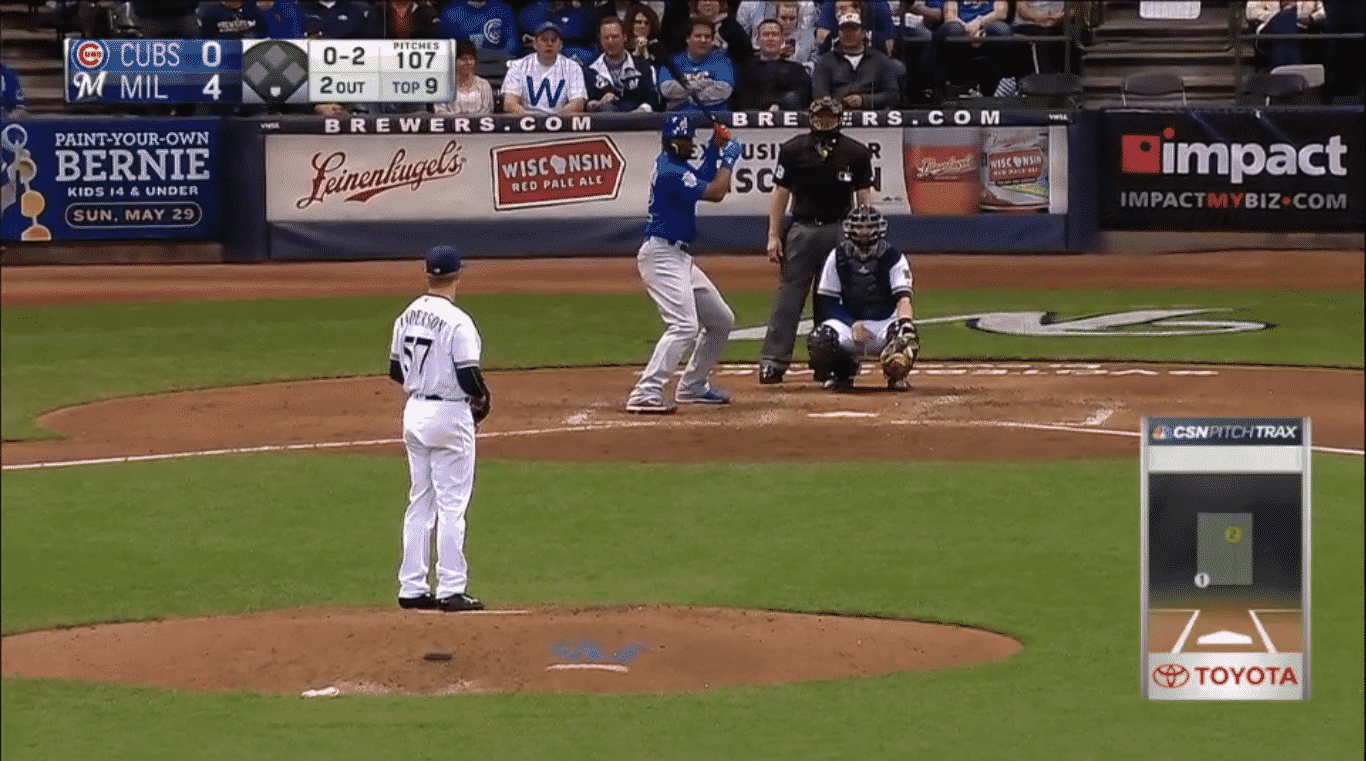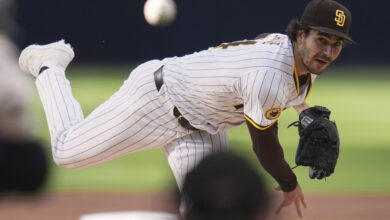
Jason Heyward Struggling to Get Into the Swing of Things
You might think swinging a baseball bat is a pretty simple exercise, but try doing it with 200 tons of expectations on your shoulders. That’s the approximate weight of 184 million dollar bills, which is what Jason Heyward appears to carrying with him to the plate since he signed with the Cubs this offseason in the most-hyped position player on the market. It’s more than just the money though. This was the first time the 26-year-old had really chosen where he was going to play. Drafted by Atlanta and traded to St. Louis, Heyward made a conscious decision to play in Chicago rather than Washington or Anaheim or St. Louis. That’s kind of a big deal.
You might think the timing of this piece is a bit odd since, at first glance, it appears as though Heyward is starting to point things in the right direction. Even after going 0-for-5 Thursday afternoon to halt a nine-game hitting streak, he’s still batting .279 over his last 10 games. That average would probably look even better were it not for some tough-luck outs here and there too. He even blasted his first home run of the season on Tuesday night, though it came with two outs in the 9th and was swallowed up by the gaping maw of a loss. Not bad, right?
Sure, I guess, but in kind of the same way as when the kids on my Little League team really get into one. These kids are all pretty young, ranging from 4 to 8, and not necessarily the most adept baseball players just yet. As such, I really try to locate my pitches so that the bats can find them. Most of these kids have tons of noise in their swings and are coming out of their shoes trying to pound every ball that comes their way.
Remind you of anyone?
Heyward’s not necessarily a free swinger, as evidenced by a 12.6% walk rate and an OBP that’s over 100 higher than his batting average. Still, it seems as though he’s really pressing up at the plate, over-swinging and trying to earn his salary with each single at-bat. I was thinking about this as I pitched to the kids tonight in the aftermath of the Cubs’ loss to the Brewers and wondering if perhaps I was just getting caught up in the internet furor over J-Hey’s slow start.
The guy is, after all, a notoriously slow starter. Maybe it’s just par for the course for him. I mean, some of those hits are going to have to start falling sooner or later. Heyward had been the victim of bad luck over the early part of the season, as evidenced by a .264 batting average on balls in play over the first 26 games. After putting up a .333 BABIP over the last 10 games, however, he’s sitting at .284, which is roughly 20 points below his career average but isn’t necessarily an indication that the gods are conspiring against him.
Then there’s the matter of the balky wrist that kept him out of the first series with Pittsburgh and that was a likely contributor to an 0-for-21 stretch in the four games leading up to the rest.
Yeah, but it also looks like there’s something amiss with the overall mechanics of Heyward’s swing. His timing seems off, his hands are all kinds of noisy, and he’s getting busted inside and then trying to jump on subsequent pitches with max effort. The result of all that is a sharp increase in soft contact (32.4% vs. 22.4% career) and an equally drastic drop in hard contact (19.8% vs. 30.6%). There’s your bad luck, folks. Can’t get as many hits if you’re not squaring the ball up as well.
I do eventually want to talk about J-Hey’s current swing, but let’s first get into its evolution throughout the course of his career. Tom Verducci did all the heavy lifting on this topic back in April, so there’s really no reason for me to invent the wheel:
Going back to 2010, his rookie year, Heyward has changed his setup at the plate every year. From a neutral stance with the hands high and the bat flat (2010), to an open stance (’11), to a slightly open stance with bent knees and pumping hands (’12), to a neutral stance with his hands lower (’13), to a closed stance with his hands away from his body and the bat upright (’14), to a slightly open stance with his arms tight to his body and the end to his odd habit of re-gripping his bat as the pitcher winds up (’15).
Alec Dopp examined the drop in Heyward’s power for Gammons Daily back in 2014 and included a couple photos to illustrate some of the differences in the hitter’s setup at the time compared to his rookie season. The photos don’t reveal anything that we didn’t get in the descriptions above, but I know some folks prefer books with pictures.
You can’t see his stance and pre-load ritual here, but I’m including this super slo-mo view of Heyward’s swing from 2014 because, well, I really liked watching it.
Okay, so that was pretty fun. In order to really see what’s going on with Heyward now, though, we need to check out some more recent examples. First up is a clip from a grand slam he hit for the Cards last season.
Note the position of the hands pre-swing: right around chin/cheek height and close to the body. I’m not a big fan of those elbows both down and tight to his sides, but that’s his thing and he’s used to it. Now note the stance (slightly open but not as much as in ’14) and the stride (short and straight forward, with a foot roll that looks almost like a broken fifth metatarsal waiting to happen). He’s a little bouncy and the hands are active during the pitcher’s windup, with a load that actually sees the hands drop a little. It’s not the most orthodox move in the world, but the stride and swing are timed up well and it’s hard to argue with this particular result.
Now let’s review that aforementioned home run in Milwaukee and observe the differences.
Heyward’s stance looks to be a little more open here, though that could just be the camera angle. The rest of the setup is pretty obviously different: hands are higher and a little farther out, elbows aren’t as tight, waggle is a little more pronounced. The knees, hips, and hands were moving last season, but it wasn’t nearly as perceptible. Now, however, Heyward looks like a little kid all hopped up on Mountain Dew and Pixie Stix. He even appears to be leaning back as the shimmy starts up top and rolls down his body.
The other notable difference is the little toe tap that closes his stance ever so slightly just prior to the actual stride. Dooch touched on this in that same article about how Heyward’s swing has changed over time.
Cubs hitting instructor John Mallee left Heyward to his own ways when the two of them first met during spring training. But as they gained trust in one another, Mallee gave Heyward another new look: a timing mechanism to get him to start earlier. It’s a slight toe tap that creates rhythm and timing to Heyward’s swing. The result? By getting started earlier, Heyward is no longer getting beat by plus fastballs on his hands.
Hmmm, no longer getting beat by plus fastballs on his hands, you say? I’m not so sure about that, mainly because of the path those hands are taking just to start the swing. The load position is still in the same spot — elbows in tight, hands in at his chest — which means that he’s having to move his hands down and in before throwing them as he strides into the swing. Compare the two pictures below, the first of which is the featured image you already saw above and the second is immediately after that little timing tap.
See what I mean? I don’t know about you, but I find it incredibly uncomfortable to have my elbows pinned in like that. Did I mention that already? Because it’s still true. I’m certainly not going to be accused of being some kind of hitting guru or anything, though I did once get walked intentionally in church league softball after hitting two homers and a triple, so I obviously know a little bit about the subject. Anyway, back to the lecture at hand.
Mallee’s little addition to Heyward’s swing might well end up being great, it’s just the other stuff surrounding it that I don’t like. Opposing pitchers, though, they seem to like it just fine. You know what I was saying about him getting beat by fastballs? Yeah, looks like the book’s out. More than ever, Heyward is being challenged by gas. Pitchers are throwing heat at a 70.2% clip, nearly 10% higher than he’s ever seen in his career thus far, and are challenging him in the zone 46.6% of the time, also a career high.
I’ve taken up quite a bit of your time already so I want to let you get back to whatever fruitless endeavor you were occupied with before you before you got sucked into this awesomeness. That said, let’s see if we can’t bring this bad boy full circle here. I opened by talking about the possibility that Heyward is pressing, that he’s carrying expectations with him to the plate. Could it be that the noise in his mind is like the rock music blaring from that abomination of a video board in left, distracting him and causing his body to dance along as he readies to swing? I’m not saying that the issues are purely psychosomatic, just that the possibility can’t be discounted out of hand.
Just so we’re clear before I leave you, I’m not sounding alarm bells here. I am, however, pointing out that these early struggles may be more than just the standard recitation about him being a slow starter (and I’m not calling anyone out, I’ve done it too). There’s still more than enough time for Heyward to settle into his new environment and new swing, and for these numbers to shift back to the mean. My hope is that I’ll look back on this in June or July and laugh about how I broke down what I perceived to be flaws, that I’ll be lauding that new timing device as the reason for his power surge.
Yep, that’s the hope.





